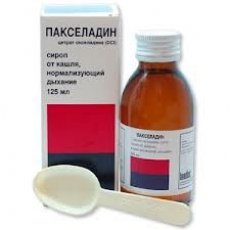Medical expert of the article
New publications
Preparations
Paxeladine
Last reviewed: 03.07.2025

All iLive content is medically reviewed or fact checked to ensure as much factual accuracy as possible.
We have strict sourcing guidelines and only link to reputable media sites, academic research institutions and, whenever possible, medically peer reviewed studies. Note that the numbers in parentheses ([1], [2], etc.) are clickable links to these studies.
If you feel that any of our content is inaccurate, out-of-date, or otherwise questionable, please select it and press Ctrl + Enter.

Paxeladine is a synthetic, non-narcotic, centrally acting cough suppressant that acts directly on the cough center and inhibits the cough reflex.
The drug has synonyms: Tusuprex, Oxeladin, Aplacol, Dorex retard, Etochlon, Gigustan, Neobex, Neusedan, Pectamol, Tussimol, etc.
Paxeladin does not depress the respiratory center and does not cause addiction or drug dependence.
Indications Paxeladine
Paxeladin is prescribed for the symptomatic treatment of non-productive (dry) cough of various etiologies. The diseases in which this drug soothes cough include:
- acute respiratory diseases,
- flu,
- acute pharyngitis,
- acute laryngitis,
- acute tracheitis,
- bronchitis (with dry cough),
- pneumonia,
- dry pleurisy,
- whooping cough.
This drug is also effective for reflex cough, which occurs when receptors located outside the respiratory tract are irritated (when the vagus nerve fibers are irritated).
Release form
The drug Paxeladin is available in the form of capsules (40 mg each) and also in the form of syrup (in 125 ml bottles, complete with a measuring spoon).
Pharmacodynamics
The pharmacodynamics of Paxeladin is determined by the active substance of this drug, which is 2-[2-(diethylamino)ethoxy]ethyl ester of α-ethylbenzeneacetic acid (international name - oxeladin citrate). Its therapeutic effect is aimed at suppressing the excitability of the cough reflex center, which is located in the autonomic center of the medulla oblongata.
At the same time, the manufacturers do not explain in the instructions for the drug the biochemical processes caused by Paxeladine, and do not provide data on how exactly Paxeladine blocks the work of the cough center, that is, does not allow its nerve fibers to perceive impulses from the receptors of the cough reflex.
Pharmacokinetics
After oral administration, Paxeladin is completely absorbed in the gastrointestinal tract and enters the blood. Depending on the dosage form of the drug (syrup or capsules), its maximum concentration in the blood plasma is noted 1-5 hours after administration. But after this, the therapeutic effect lasts for at least another four hours.
Dosing and administration
Adults are recommended to take Paxeladin capsules 1 capsule 2-3 times a day (at intervals of at least 8 hours), with 200 ml of water.
The dosage of the drug in syrup form: for adults - 5 ml 3-4 times a day (maximum daily dose - 25 ml); for children weighing 15-20 kg - 2.5 ml every 4 hours (maximum daily dose - 10 ml); for children weighing 20-30 kg - 3.5 ml every 4 hours (maximum daily dose is 15 ml).
The course of treatment with Paxeladine should not last more than three days.
 [ 1 ]
[ 1 ]
Use Paxeladine during pregnancy
The use of Paxeladin during pregnancy is not recommended, since it is not known how the drug affects the course of pregnancy and fetal development. This contraindication also applies to breastfeeding women.
Contraindications
Paxeladin is contraindicated for the treatment of cough accompanied by expectoration; narrowing of the bronchial lumen; widening of bronchial sections (bronchiectasis) in bronchial asthma.
The drug contains sucrose, so it is not prescribed to patients with diabetes. Also, Paxeladin in capsule form is not prescribed to children, and in syrup form - to children weighing up to 15 kg.
Side effects Paxeladine
Side effects of this drug may manifest themselves in the form of dyspeptic phenomena (nausea, vomiting, diarrhea), bronchospasms, and allergic skin reactions. Individual intolerance to Paxeladin is possible.
Overdose
Overdose of oxeladin citrate-based drugs may cause symptoms such as drowsiness, dyspeptic symptoms, and a drop in blood pressure. In case of overdose, activated charcoal and saline laxatives should be taken.
 [ 2 ]
[ 2 ]
Storage conditions
Paxeladine (capsules and syrup) must be stored at room temperature (not higher than +25°C).
 [ 5 ]
[ 5 ]
Shelf life
Shelf life: Paxeladin (capsules) - 5 years, Paxeladin (syrup) - 3 years.
Attention!
To simplify the perception of information, this instruction for use of the drug "Paxeladine" translated and presented in a special form on the basis of the official instructions for medical use of the drug. Before use read the annotation that came directly to medicines.
Description provided for informational purposes and is not a guide to self-healing. The need for this drug, the purpose of the treatment regimen, methods and dose of the drug is determined solely by the attending physician. Self-medication is dangerous for your health.

